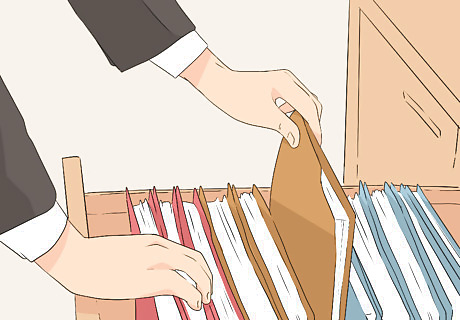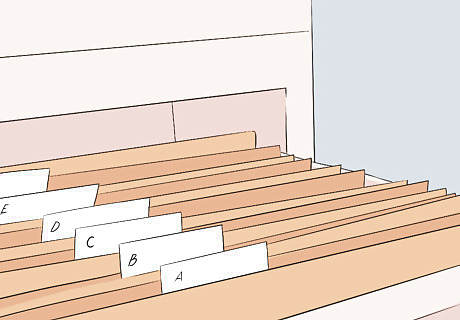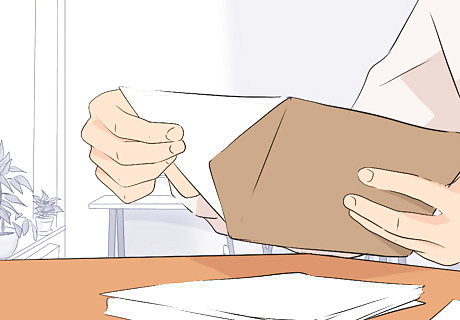
views
Systematizing

Create file categories. The first thing to do if you want to organize your files is decide what major categories you will use for sorting. Different kinds of offices will have different kinds of categories, but the general system is the same. You need to figure out a system that sorts your files in a meaningful way. For example, if you work in a law office and need to organize client files, you might sort by general case types: litigation, probate, corporate, administrative, and others.

Set up subcategories. Within each single category, you can get more specific by developing a list of subcategories. Any individual piece of paper that needs to be filed can be defined by two terms -- the general category and then the subcategory. For example, if you are setting up a filing system for financial matters, you might have a general category of “Outgoing Payments,” and then set up subcategories of vendors, suppliers, services, professionals and administrative costs.

Use a color-coding system. This sounds simple, but it can be a very effective way to organize your files for quick access. Decide how many different categories you will have in your filing system, and then use that many different colored folders. Instead of using folders that are completely colored, you can use regular manila folders and get colored stickers. You can then affix the stickers on the top tab, on the edge of the folder, or both for more visibility.

Label the files. Each file in your office now has a clear place to be. You should write the label on the tab of each folder clearly and neatly so you will know where it belongs. The label on each individual folder should start with the general category and then be followed by the specific subcategory. For example, a folder containing records of payments to your vendors would have the label, “Outgoing Payments / Vendors.” The labels on each file should be printed as neatly and consistently as possible. You can very easily buy a software packages that will allow you to format labels, so you can type and print them using your computer. If you print your labels with your computer, you should use a consistent font size and style. If you are printing by hand, you should try to be consistent and as neat as possible.

Sort the files alphabetically. When your filing system is established and you have created all your folders, then put them in order. You should sort the general folders alphabetically. Within each general folder, the subcategories should all be sorted alphabetically as well. You may choose to sort some information by date rather than by a topic label. If so, then you will need to decide for yourself if it makes more sense to sort your files with the newest items in front and move to the oldest, or vice versa.

Leave several inches of space in each filing drawer. When you are establishing your filing system, you need to leave room for the files to grow. As time goes by, you will undoubtedly receive more papers to add to each folder. Leave space for your files to expand. Otherwise, you will have the difficult task later of moving entire sections or file drawers in order to make room.
Sorting Your Files

Gather all the materials that need filing. If you are beginning with a collection of papers that have not been organized and are in disarray, you will need to begin by pulling the papers together. Find a workplace and collect everything in one pile. You will then be able to work on organizing.

Separate the papers into two groups for “action” and “filing.” As a first step, you should make a folder or pile for everything that needs immediate action. These papers should not get filed, or you may not remember to do the work that needs to be done. Set this “action” folder aside to be addressed soon. Then proceed with filing the remaining papers. Organize the “action” file. The papers that need to be dealt with immediately should be sorted into smaller groups based on the work that you need to do. For example, set up such subcategories as call, write, deliver, and pay. EXPERT TIP Ashley Moon, MA Ashley Moon, MA Professional Organizer Ashley Moon is the Founder and CEO of Creatively Neat, a virtual organizing and life coaching business based in Los Angeles, California. In addition to helping people organize their best life, she has a fabulous team of organizers ready to de-clutter your home or business. Ashley hosts workshops and speaking engagements at various venues and festivals. She has trained with Coach Approach and Heart Core for organizing and business coaching respectively. She has an MA in Human Development and Social Change from Pacific Oaks College. Ashley Moon, MA Ashley Moon, MA Professional Organizer Our Expert Agrees: Sort your papers by what needs action straight away, like bills or forms to fill out, and what doesn't require action but might in the future, like tax forms and other legal documents. The middle category of papers is those you pull out as needed, like manuals and directories. Sort the files into a drawer based on which type of action they need, placing the immediate response papers in front.

Pick up each paper once. As you sort through the loose papers that you are filing, make decisions about each one as you review it. Pick up the paper, read over it, decide which category and subcategory it belongs to in your filing system, and then put it away. Working this way will help you with consistency in your filing and will help you save time by dealing with each item only once. As you review each item, you should determine whether you even need to keep it. If the paper is something that has already been dealt with and is not something that you need to keep as a record, then consider discarding it rather than filing it.

Unfold each item. Most of the papers you have will probably have come in correspondence and are likely to be in envelopes and folded. Remove the papers from their envelopes, open them flat, and then file. Filing each paper in this way helps your folders fit uniformly in the file drawer, without bulging where the folded papers stack up. Decide whether you need to keep any envelopes. In most cases, the envelopes are unnecessary and can be discarded. However, if you believe you may need proof of delivery or proof of a postmark, then you should staple the envelope to the papers and keep them together. Multiple papers should be stapled together. This will prevent things from getting separated or lost. Staples are preferable to paper clips because (a) they fit more uniformly in the files and (b) they do not have the problem of slipping off.
Maintaining Your Files

Use a “To File” basket. When new correspondence enters your office or when new paperwork is created, you may not be able to file it right away. You should place everything that needs to be filed in a single place to be filed when you are able. A basket on your desk, labeled “To File,” is a good way to set these papers aside until you are ready.

Designate a consistent time to work on filing. If you can, schedule a consistent time each day or week that you can work on filing new papers. If you make filing a regular part of your routine, you are more likely to keep up with it. For example, you might set aside the last half hour of each day to file the day’s papers. If this is not enough time, then you might try doing your filing twice each day, just before you go to lunch and then just before leaving for the day. The keys to success are consistency and repetition.

Make sure that others with access to the files understand the system. If you are the only person using your files, then you should easily be able to maintain the order that you have created. However, if other people need to use the papers in your files, you should make sure that they understand -- and follow -- the system that you have created. Having a filing system in place is not helpful if papers get misfiled and put into incorrect folders. If may be more efficient and more effective if you offer to get anything that someone else in your office might need, and then ask them to return everything directly to you. Then you can be sure that everything gets refiled correctly.

Keep vital documents in a safe place. Some special materials may need to be held in separate, special locations. For example, some papers may need to be kept in a safe or in a fireproof lockbox. You may even need to keep some materials off-site, in a bank safety deposit box or at your company’s lawyer’s office.

Review your files regularly. At least once a year, or more frequently if necessary, you should set aside some time to review your files. The purpose of this review is to decide whether there are papers or entire folders that can be discarded or perhaps moved to an off-site storage facility. If something is never going to be needed again, then you should discard it. If it is something that you do not expect to use regularly but may need to keep as a record, then you should send it to storage.


















Comments
0 comment